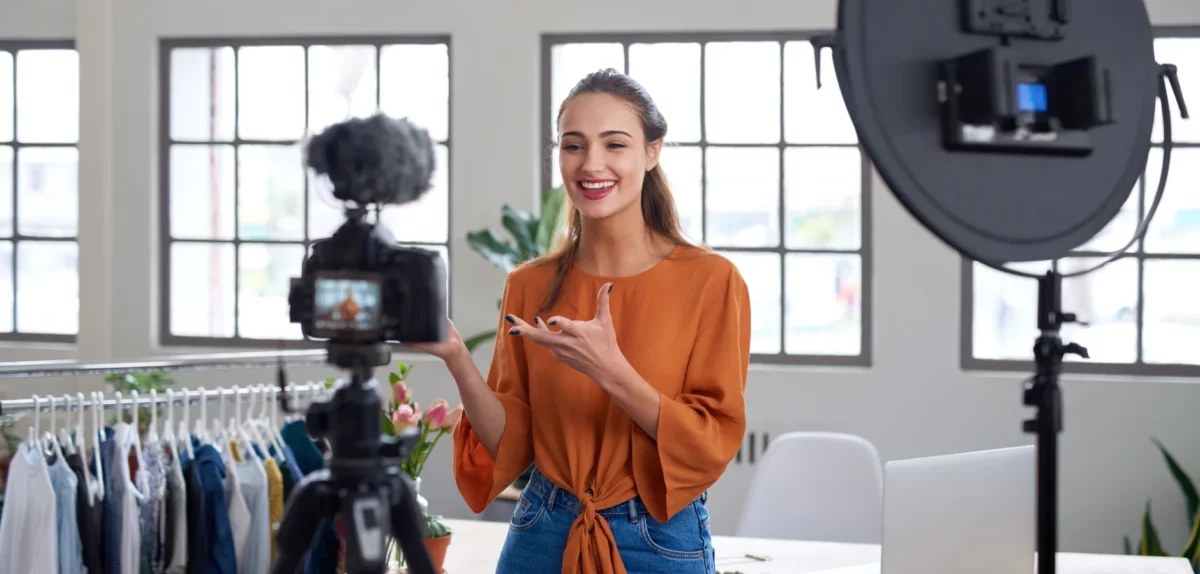Some brands just know how to craft strong influencer partnerships. A key ingredient in this recipe is recruiting creators that align with your brand’s values, and then nurture them down the line. Let’s take a page from Canon’s book:

The iconic photography brand regularly partners with high-profile influencers, including Emma Chamberlain. Emma regularly films content for her social media channels, making Canon a no-brainer partnership. Often turning into long-term partnerships, creators like Emma are invested in Canon’s products and brand story.
The Canon team actively recruits influencers through its established content creator program and targets younger audiences using its TikTok influencer program. Right now, Canon’s influencer team seems to be making all the right moves.
But not all creator partnerships programs nail the landing. We’ve all seen campaigns fall flat: low-effort posts with generic recommendations, partnerships extinguishing after one blog, tone-deaf promotions, repetitive scripts, and many more issues.
Thankfully, you don’t need to be an influencer marketing what-not-to-do example. In this blog, you’ll discover the top six mistakes brands make during creator collaborations—plus considerations for travel brands.
6 mistakes to avoid in your influencer collaborations
The global influencer market has more than tripled since 2019 (now reaching $24 billion.) It’s no wonder why so many brands are jumping on influencer partnerships to get the word out. These creators have proven track records building an audience and making savvy marketing decisions, making them perfect brand ambassadors.
Despite the booming influencer market, sustainable and profitable creator collabs require consistent planning and work. Many companies are making the same wrong turns and harming their chances of success.
So let’s uncover six common partnership mistakes—and what you can do instead.

1. Neglecting influencer relationships
Brands investing in long-term influencer partnerships see major returns on investment (ROI) as creators refine their messaging for the right audience. Yet, some neglect influencers after the honeymoon period. They stop checking in, adjusting timelines, or ceasing proactive efforts. These creators quickly feel frustrated and ghosted.
Creators are only as good as the directions you give them. Ensure you check in and support them—instead of burning bridges and missing out on the potential of well-informed, engaged partners.
Authentic recommendations from motivated creators always win. Audiences can quickly tell what rings true.
2. Skipping audience alignment
Brands build successful influencer partnerships through effective planning and alignment. When they recruit partners that connect with their audience, it just feels right. Focus on what makes sense for your target audience. You’ll know you’ve hit a bump in the road when a follower asks, “Why on Earth would they promote this product?”
Endorsements from the right content creator can make serious waves. According to Statista, nearly half of millennials trust influencer recommendations over traditional ads. Define your ideal audience up front and collaborate with influencers who reach that market to boost engagement and conversion rates.
Are you worried about not having a specific audience for your products and services? Don’t be. Just on TikTok, 86 percent of U.S. creators say that the platform’s wide-ranging content empowers them to try out new topics and formats. The right audience is out there for you. And, there are creators excited to partner with you right away.
3. Overlooking the value of authenticity
Genuine and honest content is key to successful brands. Some brands allow creators to promote products they haven’t used. Here, you risk alienating followers from your brand (and the creator) by making them feel deceived.
Data collected by impact.com shows that 64 percent of consumers repeatedly purchase based on influencer recommendations. So, encourage partners to be open about partnerships. Focus on transparency and real product impressions. You’ll start building trust with audiences and lasting connections with great partners.
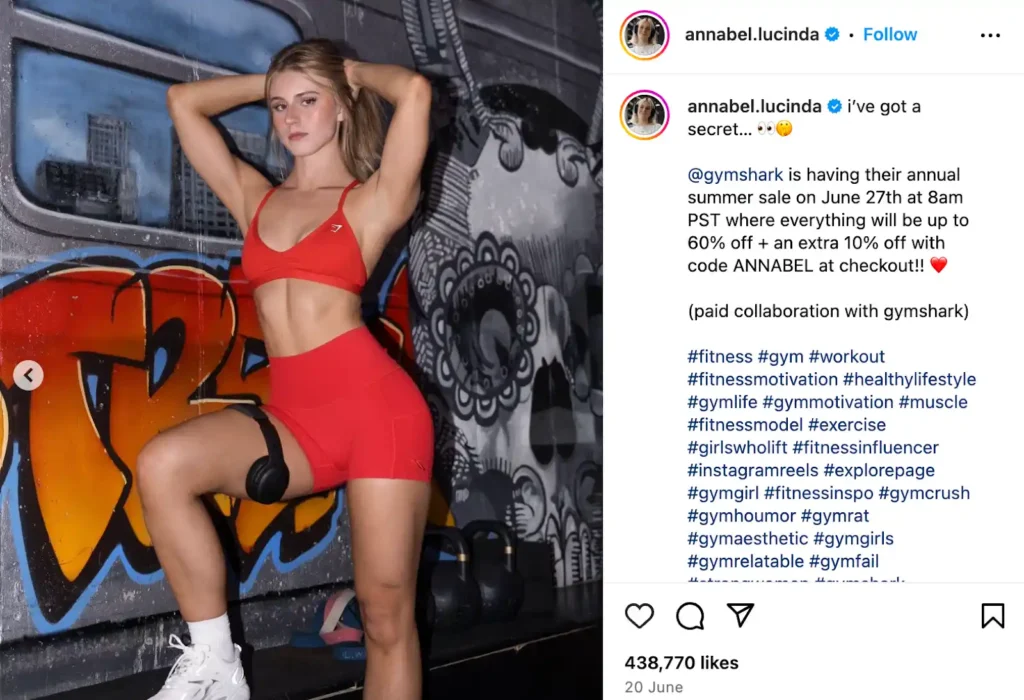
Athletic apparel brand Gymshark consistently partners with fitness influencers to promote its products. Take this Instagram post with Annabel Lucinda, in which the influencer’s audience can get an extra 10% off using Annabel’s promo code.
4. Forgetting clear calls-to-action
You’ve found the right audience and teamed up with skilled influencers. Now’s the time to see tangible results. Here’s where some marketers trip at the final hurdle: skipping the call-to-action (CTA).
These CTAs range from links to promo codes. But that’s not all—you also need to give them a compelling reason to follow through. Highlight the next desired action: click this link to learn more today, or visit our website and save with this discount code.
Your audience should know what to do next. CTAs turn engaging content into posts with tangible ROI. Encourage partners to personalize CTAs, experiment, and track click-through rates (CTRs) using platform’s like impact.com’s reporting tools to measure effectiveness and areas for improvement.
5. Mistreating long-term relationships
After touching on maintaining healthy partnerships earlier, let’s explain why many brands struggle to keep top creators around.
Some teams fall into the trap of launching one-off campaigns without proper planning or consistency, hindering lasting relationships with influencers. Long-term partnerships offer cost-effective solutions by building a deep understanding and inspiring ideas for future campaigns. So, start year-long campaigns with your favorite creators. Invite them to in-person experiences or share personalized rewards. See what schedules and resources would be best for them. Happy partners will also refer your program to other creators, expanding opportunities.
Pro tip: Focus on being easy to work with and letting creators do their job.
6. De-emphasizing content quality
Compelling content should come first. Data from impact.com’s research shows that 58 percent of people follow creators for fun, entertaining content.
Focus on creating high-quality, shareable content that provides value or entertains your audience.
Your influencer campaigns rely on connecting with audiences and winning them over. So, lean on your partner’s strengths. Ask yourself: What made their content fun and engaging in the first place? How did they build a following? Your brand collab should add to what is already working and genuine about the creator’s content.
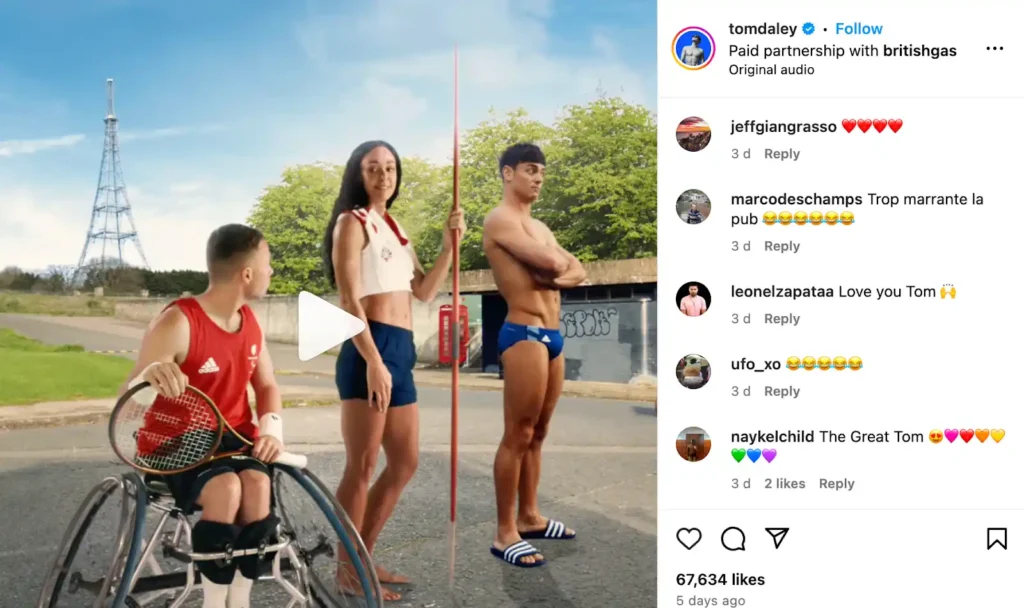
British Gas capitalized on the buzz surrounding the 2024 Olympics, partnering with fellow British Olympic athletes Tom Daley, Katarina Johnson-Thompson, and Alfie Hewett on a series of entertaining videos and exciting competitions.
Mapping out influencer partnerships as a travel brand
Let’s zero in on the travel industry and how brands are making smart partnership decisions. According to Statista, 84 percent of U.S. adults consult travel influencers for trip planning at some level.
Travel content makes up a significant chunk of the overall influencer market—and these recommendations have direct, real-world impacts. Here’s how you should plan your influencer partnerships as a travel brand:
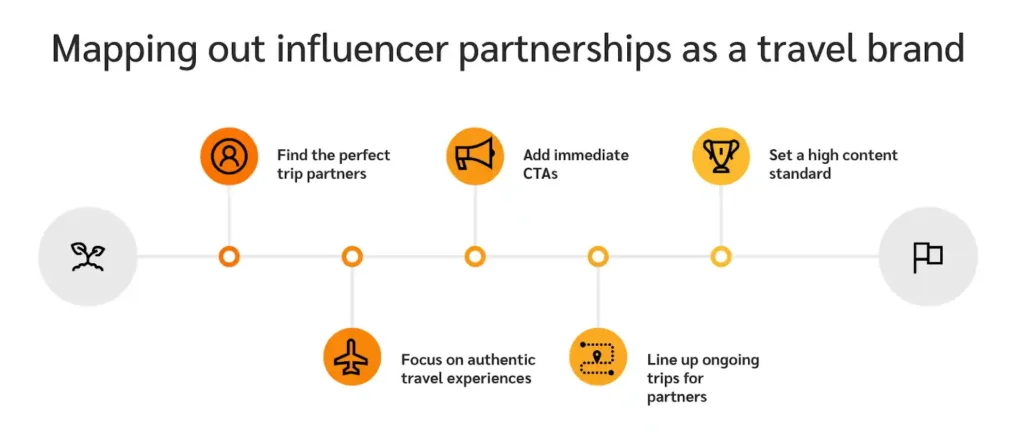
Find the perfect trip partners
Good travel brands keep audience alignment in mind. Suppose you’re an Icelandic rugged, outdoor clothing brand like 66North, partner with a travel influencer and photographer like Alex Strohl. Instead of just trying on a jacket or repeating the specs, he’ll highlight clothing through eye-catching posts about outdoor adventures:
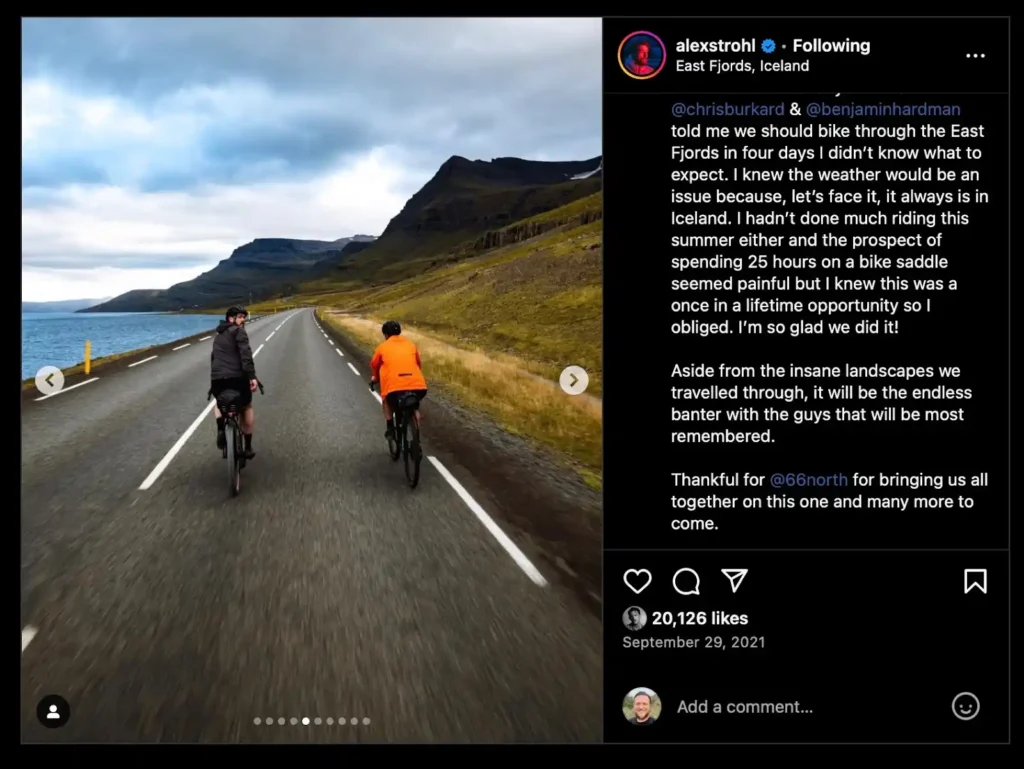
Focus on authentic travel experiences
Successful travel brands encourage creators to create useful guides and honest reviews for their followers. Here’s where to go, the best places to see, the tips we learned along the way, and more. That’s the kind of content people rely on when planning their dream trips. Savvy audiences can tell who has real experience and passion—and who is throwing together vague content for views.
Add immediate CTAs
Travel brands with strong partnership programs know the value of compelling CTAs. Click here to book your trip. Sign up for the backpacking adventure. Grab the perfect backpack before we run out. If you want trip planners to choose you, the process should always be as clear and straightforward as possible.
Line up ongoing trips for partners
Travel content opens up so much potential for ongoing brand partnerships. By teaming up with the same influencer again, brands can show off different adventures and trip packages. They’ll highlight different parts of each destination and country. This lasting partnership boosts brand credibility and trust for audiences invested in a specific creator. They’ll get to go on so many journeys with their favorite travel influencer—and hopefully book their own one day.
Set a high content standard
Finally, experienced travel brands focus on quality content. Blurry, low-resolution images, or poorly written travel stories will quickly drag a campaign down. Travel content should inspire and entertain audiences—encouraging them to follow along and respond to each CTA.
But, captivating posts and stories will draw in your ideal audience and showcase your brand in the best possible light. For example, the travel influencer Bree Rose sets a high standard with beautiful shots and videos. Brands like Hilton benefit from these influencers going the extra mile.
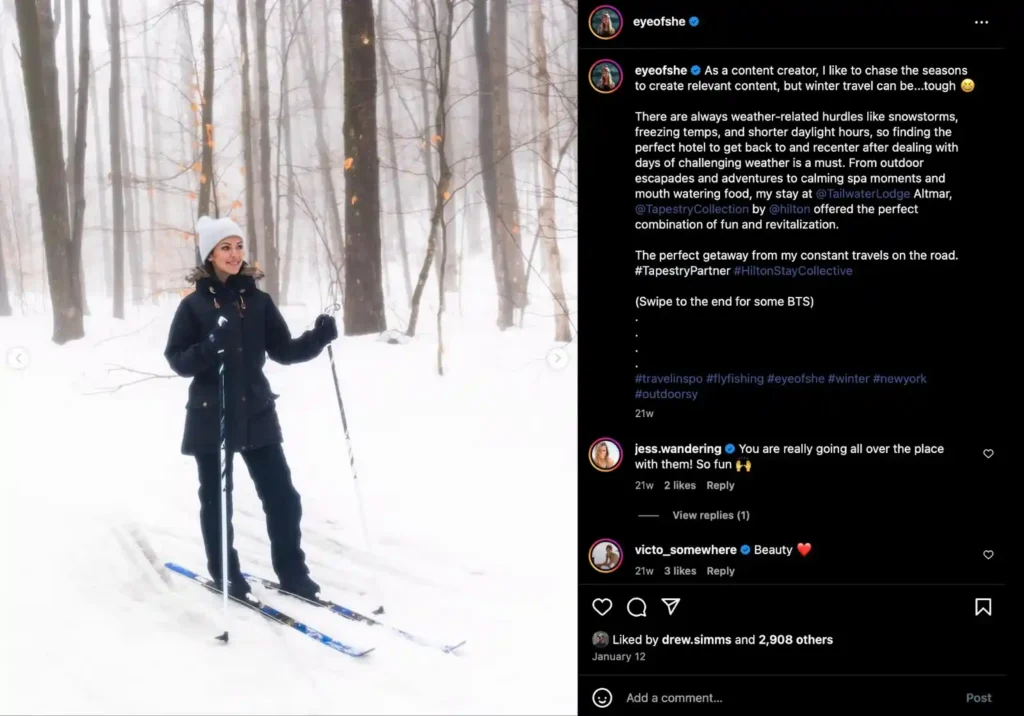
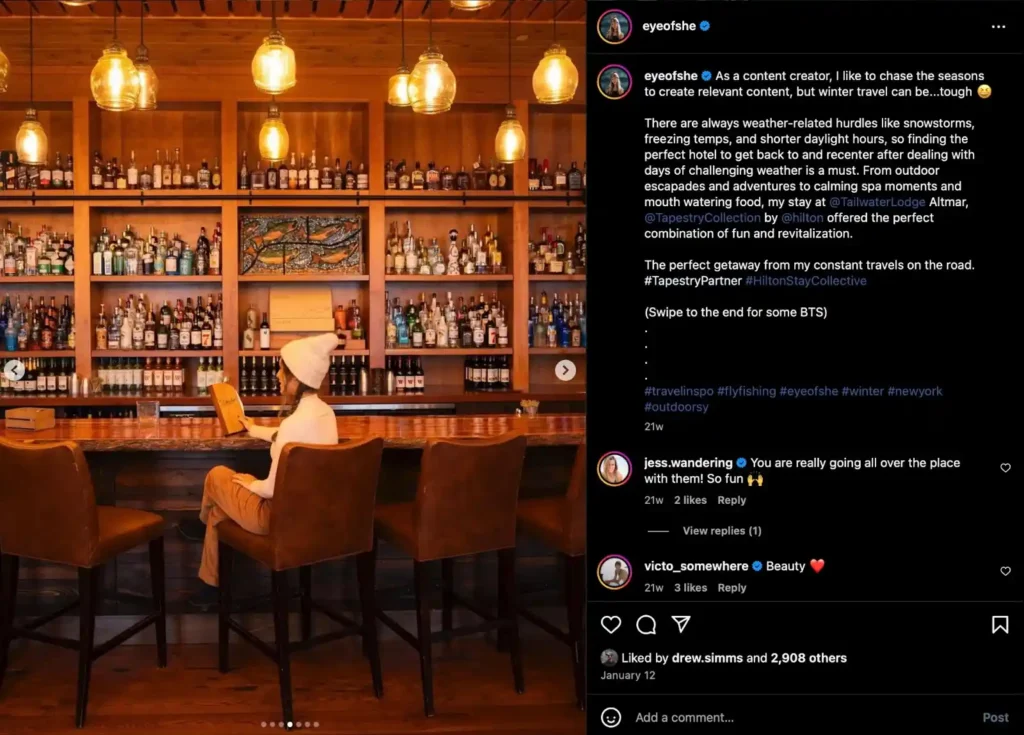
FAQs
Treat your influencer partners as long-term collaborators and make sure they feel supported with great resources and consistent check-ins. Plan campaigns with influencers of all sizes—using bigger creators to spread brand awareness and smaller influencers to reach niche markets.
Creators bring existing audiences to the table, helping you find your target audience right away. You’re already halfway there when you’ve teamed up with influencers already focused on topics and products in your industry. Over time, these talented creators become great ambassadors for your brand. That’s why building the right partnerships from the start is so important.
Choosing the right influencers is crucial. If their style, content, and interests don’t align with yours, you’ll be wasting time and resources before your campaigns start. You can reach out to content creators in your industry or promote your program’s benefits on your website. However, a marketplace with customized filters and signed-up creators is the best place to start. Consider impact.com / creator’s Marketplace for your needs.
Avoid common partnership pitfalls to see lasting success
Influencer collaborations are ideal for boosting brand visibility and credibility, no matter the industry. Understanding common partnership pitfalls gives you a competitive edge.
Nurture your partners from start to finish, ensuring they align with your targeted audience. Emphasize authenticity and clear CTAs. Lastly, treat your partners with a long-term mindset, offer creative freedom, and promote high-quality content.
By avoiding typical errors, you can cultivate positive relationships with skilled content creators and maximize your campaign’s ROI. Check out impact.com / creator for a unified partnership experience and equip yourself with the tools to stand out.




